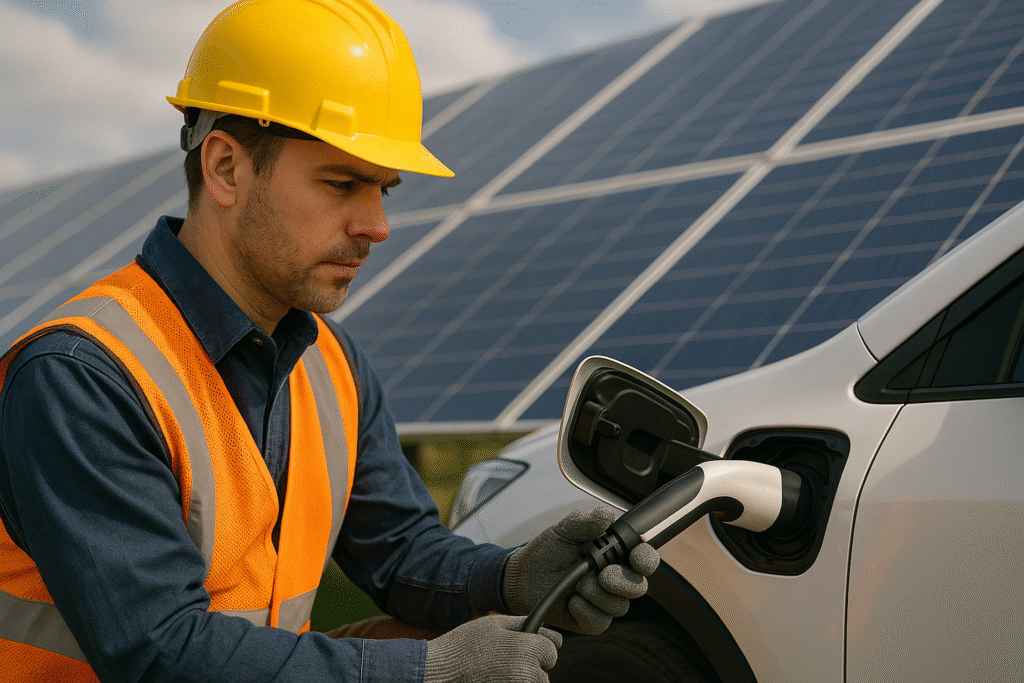Battery and Electrical Safety for Mobile Workforces is a critical, yet often overlooked, aspect of occupational health and safety.
In today’s dynamic work environments—where mobile workforces operate in vehicles, temporary job sites, remote facilities, or customer premises—exposure to battery-related and electrical hazards is increasing.

While these workers may be highly mobile, safety practices should never be left behind.
Whether you’re servicing telecom towers, performing roadside repairs, conducting field inspections, or delivering products, staying protected from electrical hazards is non-negotiable.
- Understanding the Risks: Why Battery and Electrical Safety Matters
- Common Battery Types Used in Mobile Workforces
- Top Electrical Safety Practices for Mobile Workers
- Safe Battery Charging Tips
- Emergency Response Tips for Battery and Electrical Incidents
- Special Considerations for EV Fleets and Solar-Powered Equipment
- Training and Policy Recommendations
- Final Thoughts
Understanding the Risks: Why Battery and Electrical Safety Matters
Mobile workers are exposed to a unique combination of electrical risks and battery-related hazards. These can include:
- Electrical shock from exposed wiring or faulty power tools.
- Thermal burns due to battery overheating or electrical faults.
- Chemical exposure from leaking batteries.
- Fire and explosion caused by damaged lithium-ion batteries or overcharged equipment.
- Ergonomic strain from handling heavy battery packs or portable generators.
In environments where there’s no on-site electrician, and jobs often rely on improvised setups, these risks can multiply quickly.
According to the Canadian Centre for Occupational Health and Safety (CCOHS), over 1,000 electrical incidents are reported annually, many of them preventable through proper training and equipment handling.
Common Battery Types Used in Mobile Workforces
It’s important to know the types of batteries mobile workers often use:
| Battery Type | Common Uses | Hazards |
|---|---|---|
| Lithium-ion (Li-ion) | Power tools, laptops, tablets | Overheating, explosion |
| Lead-acid | Vehicle batteries, backup power | Acid leaks, heavy lifting injury |
| Nickel-Metal Hydride (NiMH) | Radios, medical gear | Short circuits |
| Alkaline | Flashlights, small devices | Leakage when stored improperly |
Each type requires different storage, charging, and disposal practices. Not knowing these specifics can lead to serious injuries and equipment damage.
Top Electrical Safety Practices for Mobile Workers

1. Perform Visual Inspections Daily
Before using any battery-powered or electrical equipment, check for:
- Frayed wires
- Loose terminals
- Burn marks or smells
- Swollen battery cases
Damaged items should be tagged out and not used until repaired or replaced.
2. Use Ground Fault Circuit Interrupters (GFCIs)
GFCIs prevent electrocution when using tools in wet or damp environments. Portable versions are available for use at temporary worksites or outdoors.
3. Label and Store Batteries Safely
Batteries should be:
- Kept in their original packaging or a plastic container
- Away from metal objects like tools or coins (to prevent short circuits)
- Stored at moderate temperatures away from direct sunlight or moisture
4. Use the Right Charger
Only use the manufacturer-approved charger for the battery or device. Using the wrong charger can cause overheating or fire.
5. Avoid Daisy-Chaining Power Strips
Daisy chaining—plugging multiple power strips into one another—is a common but dangerous practice that can lead to overloads and fire.
Safe Battery Charging Tips
Charging batteries while on the move? Follow these rules:
- Don’t charge batteries in direct sunlight or confined spaces.
- Ensure good ventilation when charging lead-acid batteries.
- Keep chargers away from flammable materials.
- Always unplug chargers once batteries are fully charged.
- Do not leave batteries charging overnight in vehicles.
Emergency Response Tips for Battery and Electrical Incidents
Every mobile unit should carry a battery spill kit and be trained in electrical first aid.
For battery leaks:
- Ventilate the area.
- Use gloves and eye protection.
- Neutralize acid with baking soda (for lead-acid).
- Dispose of contaminated materials following Environment Canada hazardous waste regulations.
For electrical shock:
- Cut power immediately if safe to do so.
- Do not touch the person if they are still in contact with the source.
- Call emergency services.
- Begin CPR if the person is unresponsive and you are trained.
Special Considerations for EV Fleets and Solar-Powered Equipment
With more companies switching to electric vehicles (EVs) and solar setups, new risks emerge:

- EV battery fires can be harder to extinguish and may reignite hours later.
- Improperly grounded solar units can shock or burn installers.
- Always follow manufacturer and CSA Group standards when working with high-voltage systems.
If your fleet includes EVs, train all drivers on battery fire protocols and make sure emergency responders are aware of your battery types.
Training and Policy Recommendations
To reduce risks and ensure safe operations, employers should:
- Develop a Battery and Electrical Safety Policy
- Include this training in onboarding and annual refreshers
- Provide mobile safety toolkits with PPE, spill kits, GFCI units, and fire extinguishers
- Keep up-to-date with regulations from OHSE.ca, CCOHS, and NFPA
Final Thoughts
Whether you’re powering tools on a jobsite or charging laptops in a mobile office, Battery and Electrical Safety for Mobile Workforces should never be left to chance. Simple mistakes—like overcharging a lithium-ion battery or working without GFCI protection—can lead to fires, explosions, or life-threatening injuries.
Equip your team with the right knowledge, gear, and procedures to keep safety at the forefront—wherever the job takes them.

No comments yet